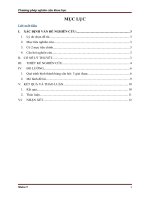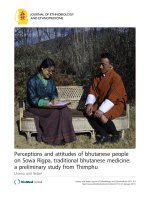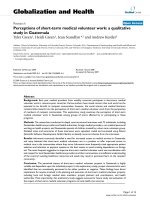A qualitative study in parental perceptions and understanding of SIDS-reduction guidance in a UK bi-cultural urban community
Bạn đang xem bản rút gọn của tài liệu. Xem và tải ngay bản đầy đủ của tài liệu tại đây (433.33 KB, 6 trang )
Crane and Ball BMC Pediatrics (2016) 16:23
DOI 10.1186/s12887-016-0560-7
RESEARCH ARTICLE
Open Access
A qualitative study in parental perceptions
and understanding of SIDS-reduction
guidance in a UK bi-cultural urban
community
Denise Crane* and Helen L. Ball
Abstract
Background: Differences in both Sudden Infant Death Syndrome (SIDS) rates and infant care practices between white
British and South Asians in UK are well known, but research has not yet examined how these two groups understand and
implement SIDS-reduction guidance. This study aimed to discover how white British and Pakistani mothers in Bradford
recall, understand and interpret SIDS-reduction guidance, and to explore whether and how they implement this guidance
in caring for their infants.
Methods: In-depth narrative interviews with 46 mothers (25 white British origin and 21 Pakistani origin) of 8–12 week old
infants recruited from the pool of participants enrolled in the ‘Born in Bradford’ (BiB) cohort study.
Results: All mothers were aware of UK SIDS-reduction guidance from leaflets presented to them during antenatal or
postnatal interactions with health care providers. Pakistani mothers tended to dismiss the guidance in toto as being
irrelevant to their cultural practices; white British mothers dismissed, adapted and adopted aspects of the guidance to
suit their preferred parenting decisions and personal circumstances. Many mothers misunderstood or misinterpreted
the guidance given and explained their infant care behaviour according to their social and cultural circumstances.
Conclusions: Current SIDS reduction information in the UK does not meet the needs of immigrant families, and is easily
misinterpreted or misunderstood by mothers from all sections of the community. Tailored information acknowledging
cultural differences in infant care practices is vital, as is greater discussion with all mothers about the reasons for SIDS
reduction guidance.
Keywords: Sudden infant death syndrome, SIDS reduction, Infant care, Bi-cultural, Qualitative research
Background
Unexplained sleep-related infant mortality (Sudden Infant
Death Syndrome) is closely related to infant care practices
and can vary substantially between immigrant and host
populations [1–6]. Differences in infant care practices
between white British and UK Pakistani mothers have
been well documented, as has the much lower prevalence
of Sudden Infant Death Syndrome (SIDS) of South Asian
Infants in UK [7, 8]. The overall UK SIDS rate is currently 0.3/1000 live births, or approximately 250 infant
deaths per year [9]. Current SIDS-reduction guidance is
* Correspondence:
Department of Anthropology, Durham University, Dawson Building, South
Road, Durham DH1 3LE, UK
disseminated by health professionals (usually by means
of leaflets often in multiple languages) at prenatal and
postnatal contacts. Although it is known that South
Asian infant care protects infants from the most important SIDS-related factors such as cigarette smoking,
alcohol consumption, sofa-sharing, prone sleep and
solitary sleep, research has not explored why parents
appear to follow some guidelines and not others [7, 8].
The present study aimed to elicit detailed qualitative
explanations for inter-cultural differences in infant care
in the bi-cultural community of Bradford and explore
the cultural context in which infant care is performed in
order to inform future public health interventions in this
and similar ethnically diverse populations.
© 2016 Crane and Ball. Open Access This article is distributed under the terms of the Creative Commons Attribution 4.0
International License ( which permits unrestricted use, distribution, and
reproduction in any medium, provided you give appropriate credit to the original author(s) and the source, provide a link to
the Creative Commons license, and indicate if changes were made. The Creative Commons Public Domain Dedication waiver
( applies to the data made available in this article, unless otherwise stated.
Crane and Ball BMC Pediatrics (2016) 16:23
Methods
The consolidated criteria for reporting qualitative research (COREQ) are used to describe the study methods.
COREQ provides a 32-item checklist for explicit and
comprehensive reporting of qualitative studies (in-depth
interviews and focus groups) [10].
We aimed to conduct 50 in-depth narrative interviews
to obtain qualitative data from mothers of 8–12 week old
infants (this age group is the peak age-range for SIDS in
the UK). Recruitment was conducted at Bradford Royal
Infirmary Maternity Unit when the mothers-to-be were
28 weeks pregnant and being recruited into the ‘Born in
Bradford’ (BiB) cohort study. A purposive sample of 137
BiB participants were approached and asked if they would
agree to be interviewed when their infants were 8–12
weeks old; although 69 agreed to be contacted 23 were
lost from the sample due to changes in contact details or
relocation outside of the Bradford area–therefore 25 white
British and 21 Pakistani mothers (n = 46) were interviewed. Of the 21 Pakistani mothers that were interviewed
5 were first generation (born in Pakistan) and sixteen were
second generation (born in the UK).
All interviews were conducted and analysed by the
first author, a white British mature female researcher
with training and expertise in qualitative interviewing,
with guidance and supervision by the second author.
Interviews were audio-taped and took place face-to-face
at the participants’ homes and guided with the use of an
Interview Schedule (Additional File 1). They were conducted in 4 equal batches from the two ethnic groups
concurrently to ensure that developing themes were explored and cross-checked. The interviewer produced
verbatim transcripts which were thematically analysed
via a continuous comparative method as they were generated. Themes were discussed and agreed by both authors.
Ethical approval was granted by Durham University
and the NHS National Research Ethics Committee of
Yorkshire and the Humber. R&D Management approval
was granted by Bradford Teaching Hospitals NHS Foundation Trust and Bradford Institute for Health Research.
Participants received oral and written information about
the study at recruitment and again prior to the interview
when written consent was obtained.
Results
Socio-demographic information was obtained from the
BiB database and confirmed with participants at interview (see Table 1 below). The participants inhabited the
same geographical areas of Bradford with 20/21 Pakistani mothers and 23/25 white British mothers residing
in the socio-economically deprived inner-city.
All participants knew about SIDS-reduction guidance,
however, safe sleep practices were implemented variably
(see Table 2 below). White British mothers acknowledged
Page 2 of 6
Table 1 Characteristics of the Participants
White British (n = 25)
Pakistani (n = 21)
27.2 (19–38)
28.5 (20–41)
Married
15 (60 %)
19 (90 %)
Partnered
4 (16 %)
0
Single
6 (24 %)
2 (10 %)
First Time Mother
15 (60 %)
9 (43 %)
3 (12 %)
1 (5 %)
Mean Age (Range)
Marital Status
Educational Status
Degree or Higher
A-level or equivalent
10 (40 %)
6 (29 %)
GCSE or equivalent
12 (48 %)
11 (52 %)
No qualifications
0
3 (14 %)
Employed
6 (24 %)
3 (14 %)
the recommendations to keep babies in their room for the
first 6 months yet 7/25 were in separate bedrooms before
3 months of age: “I really don’t want him to get used to
being in our bedroom…I think the 6 month thing is just
too old”; “She’s going to be in her own room soon. I don’t
think she needs to be with me till she’s as old as
6 months.” White British mothers also tended to place
their infants in separate rooms for daytime sleep for
quietness, ‘privacy’ and to allow mothers time to carry
out chores. Pakistani mothers kept their babies in the
parental bedroom at night and close to them during
daytime sleep: “I like him with me even if he’s sleeping. I
know the English put their babies in their own rooms
but Pakistani mums don’t do that.”; “Pakistani families
always have the babies there…in daytime and in night.
It’s just expected…it wouldn’t feel right if my babies
weren’t with me.”
All white British mothers were familiar with recommendations to place babies supine and ‘feet-to-foot’,
although a third reported that sometimes infants slept
on their side. Some mothers questioned whether infants
could roll from the side to the prone position during
sleep: “I mean she’s too little to be able to get herself right
over onto her tummy, isn’t she?” All Pakistani mothers
placed their babies supine for sleep but about half did
not implement the feet-to-foot position due to the use
of ‘infant pillows’. These items are not typical Europeanstyle pillows but thin infant head positioners that pose
negligible suffocation or re-breathing risks due to their
inability to mould around the infant’s face. The use of
such ‘pillows’ was described as a valued tradition amongst
Pakistani families and several mothers reported they were
used against the explicit advice of health professionals:
“Even if they tell you not to use them, the mothers still use
them anyway. I mean, they aren’t there 24/7 so the
mothers just say they don’t use them and when they’re gone
get them back out…it just saves the hassle.”
Crane and Ball BMC Pediatrics (2016) 16:23
Page 3 of 6
Table 2 The Participants’ Infant Care Behaviours
Night-Time Sleep
Location
Infant Daytime Sleep
Location
Sleep Surfacea
White British
Pakistani
Parents Room = 18
(72 %)
Parents Room = 21
(100 %)
Own Room = 7
(28 %)
Own Room = 0
Separate Room = 16
(64 %)
Separate Room = 4
(19 %)
Same Room = 9
(36 %)
Same Room = 17
(81 %)
Cot/Crib/Moses
Cot/Crib/Moses
basket/Bassinette = 23 basket/Bassinette =
(92 %)
13 (62 %)
Bed Sharing = 2 (8 %) Bed Sharing = 8
(38 %)
Sleep Beddingb
Sleep Position
Sleep Surface Positionc
Sofa-Sharing
Infant Temperature
Concerns
Sleeping bag = 17
(68 %)
Sleeping bag = 4
(19 %)
Sheets/blankets = 8
(32 %)
Sheets/blankets = 17
(81 %)
Pillow = 0
Pillow = 11 (52 %)
Back = 17 (68 %)
Back = 21 (100 %)
Back/side = 8 (32 %)
Back/side = 0
Feet to Foot = 25
(100 %)
Feet to Foot = 9
(43 %)
Top/middle = 0
Top/middle = 12
(57 %)
Yes (more than
once) = 5 (20 %)
Yes (more than
once) = 0
Yes (once) = 3 (12 %)
Yes (once) = 0
No = 17 (68 %)
No = 21 (100 %)
Hot = 23 (92 %)
Hot = 0
Cold = 0
Cold = 14 (67 %)
Both = 2 (8 %)
Both = 7 (33 %)
Use of Baby Intercom
Systems
Yes = 18 (72 %)
Yes = 0
No = 7 (28 %)
No = 21 (100 %)
Use of Infant
Temperature Monitors
Yes = 25 (100 %)
Yes = 3 (14 %)
No = 0
No = 18 (86 %)
Infant Feeding
Dummy (Pacifier) Use
Breast = 10 (40 %)
Breast = 8 (38 %)
Formula = 15 (60 %)
Formula = 10 (48 %)
Both = 0
Both = 3 (14 %)
Yes = 13 (52 %)
Yes = 3 (14 %)
No = 12 (48 %)
No = 18 (86 %)
a
Specific type of bed or mattress was not determined for bed sharing
b
Sleeping bag is an infant night garment (gro-bag, sleep sack etc.)
c
Feet to Foot is to position infants with their feet to the bottom of the crib or cot
and not the Asian women. I know what’s best for my
babies and I like them with me at night.”
All white British mothers reported that they would
avoid bed-sharing, implementing alternate options for
feeding their babies during the night: “I used to let her
sleep with me cos she were feeding 2, 3 or even 4 times in
night and I were really careful with her. I suppose I
stopped cos I felt guilty, cos I know it’s not recommended,
cos it’s a bit dangerous for them, but it was just so much
easier for her to feed and for me.” Although cautious of
bed-sharing, a third of white British mothers reported
sleeping on a sofa with their babies even while acknowledging the advice not to do so: “I know they tell you not
to but sometimes it’s hard when they’re up in night…I
know I wouldn’t do it if I thought that I could hurt my
baby so I was always careful.” Some mothers avoided
sofa-sharing by regularly using an armchair: “I always
just sit on a chair…I don’t sit on sofa cos I know it’s
dangerous and it’s more possible to fall asleep on sofa.”
In contrast Pakistani mothers reported never sofa-sharing
which was explained as being socially and culturally unacceptable in Pakistani households: “The leaflets they give
you say that you shouldn’t sleep on sofas with babies cos
it’s dangerous but it’s just something the English do cos a
respectful Asian woman just wouldn’t do that.”
SIDS-reduction guidance emphasises the importance of
preventing babies from overheating. Pakistani mothers
were aware of this, but none were concerned about their
infant becoming too hot: “I don’t think the Pakistani
mothers worry about the hot like the English do cos that’s
always in the leaflets and stuff cos of cot death…They don’t
ever mention anything about how being cold can make you
poorly as well though do they? I suppose it’s more for the
English.” In contrast the white British mothers expressed
concern about their babies becoming too hot due to the
fear of SIDS and all used room temperature monitors for
reassurance in contrast to Pakistani mothers who did not
use temperature monitors.
Table 3 (below) displays the prevalence of cigarette
smoking and alcohol consumption among the participants. All Pakistani mothers were aware of the link
between maternal smoking and SIDS-risk although not
of the association between paternal smoking and SIDS:
“I know mothers shouldn’t smoke and good Pakistani
women don’t smoke. I don’t think it’s as important about
fathers, is it?” All of the white British mothers knew of
Table 3 Parental Smoking and Alcohol Consumption
Recommendations to avoid bed-sharing with an infant
were known to the Pakistani mothers who expressed
strong beliefs about this practice and dismissed guidance
that babies should sleep in a cot near the parents’ bed,
feeling this information was not directed to them: “Most
of the stuff they write is meant for the English mothers
White British
Pakistani
Maternal Cigarette Smoking
3 (12 %)
0
Maternal Alcohol Consumption
15 (60 %)
0
Paternal Cigarette Smoking
2 (8 %)
4 (19 %)
Paternal Alcohol Consumption
17 (68 %)
0
Crane and Ball BMC Pediatrics (2016) 16:23
the smoking and SIDS association but those who
reported smoking modified their behaviour: “I tried to
stop but can’t. I never smoke near [baby]…I only smoke
outside and never in here so it don’t affect her.”
Pakistani mothers and fathers reported no alcohol
consumption and considered this advice as being for
‘English’ families: “I don’t really think that stuff about
smoking and drinking in them leaflets… it’s not for us…
it’s aimed at the English mothers really isn’t it?” White
British mothers acknowledged the advice regarding alcohol consumption and SIDS but those who consumed
alcohol reported they ‘only drank at weekends’ or ‘on
special occasions’ and they ‘did not get drunk’. They did
not feel that paternal alcohol consumption was relevant.
Several white British mothers believed that advice regarding smoking and alcohol related to bed-sharing or
breastfeeding mothers only: “I know there’s risk with
smoking and drinking when you have your baby in bed
with you but I can’t see how smoking or a little drink can
affect a baby when you’re not sleeping together…I don’t
have my baby in bed with me and I don’t breastfeed now
so it don’t affect us.”
Overall none of the mothers interviewed followed all
SIDS-reduction guidance and some implemented very little. While some Pakistani infant care practices corresponded with SIDS-reduction guidance this reflected
cultural practice and was more coincidental than planned.
White British mothers followed their personal preferences.
The reasons supporting SIDS-reduction guidance were
poorly understood.
Discussion
Mothers living in the same neighbourhoods of a northern UK city, who had received and were aware of national SIDS-reduction guidance, implemented different
infant sleeping practices for personal and cultural reasons. Many SIDS-reduction practices were part of normal Pakistani infant care (supine sleep; room-sharing;
avoiding alcohol, smoking and sofa-sharing); as much of
the guidance was irrelevant to Pakistani mothers they
felt that Safe Sleep guidance was not directed to them.
Consequently, where the guidance conflicted with traditional Pakistani beliefs about infant sleep (bed-sharing,
pillow use, overheating) mothers prioritised their traditional practices and dismissed the official guidance.
White British mothers consciously adapted or dismissed
several aspects of the guidance (room-sharing; avoiding
sofa-sharing) that they felt to be not applicable or unnecessary, while questioning others (lateral sleep position;
any smoking or alcohol consumption). Their responses
also suggested that the implementation of some SIDSreduction practices compensated for the lack of others,
highlighting parental perceptions that risk-reduction strategies can be traded against each other.
Page 4 of 6
Growing evidence indicates that SIDS is less prevalent
among infants who sleep near their parents [11–13].
However, keeping babies in the parental bedroom for
6 months was dismissed by many white British mothers
who also placed their infants in separate rooms for daytime sleep: solitary sleep both at night and during the
day was a common white British infant care practice.
These participants were unaware that adult presence
during daytime sleep is equally important as for nighttime sleep [14, 15].
In previous research we found that Pakistani infants
were significantly less likely than white British infants
to sofa-share [7, 8]. In the present study Pakistani
mothers explained that lying on a sofa was socially and
culturally unacceptable, signifying laziness; Pakistani
women remained in their bedrooms at night to feed
their babies. White British mothers attempted to avoid
bed-sharing by sofa-sharing, propping themselves up in
bed, or using armchairs to feed their infants at night,
even though SIDS-reduction guidelines includes avoidance of sofas and armchairs for night-time feeding.
There is no specific advice to parents on how to feed
babies safely during the night; this is an important
omission that leaves mothers trying to choose between
several apparently dangerous locations.
All white British mothers were aware of dangers in
their baby’s sleeping environment; the majority did not
use pillows or blankets preferring baby sleeping bags for
night-time sleep. Pakistani mothers preferred sheets and
blankets and infant ‘pillows’ (head positioners) even though
they were aware of disapproval from health professionals
regarding the latter. White British mothers were sceptical
of the advice to avoid the side sleep position for infants,
however, studies from England and New Zealand have
shown that this position is unstable and infants risk rolling
into the prone position [16–19]. Participants were unaware
of this instability or that side sleeping infants could fall into
the prone position before they were physically capable of
rolling, suggesting some explanation is needed here.
Multiple studies have confirmed an association between maternal smoking, alcohol consumption and SIDS
[20–23]. White British mothers’ attitudes to alcohol consumption warrants further research as some participants
were unaware that alcohol could influence their infant
care judgements and decisions (such as unintentionally
falling asleep with a baby on a sofa). Furthermore, and
importantly, many white British mothers believed smoking and alcohol consumption to be factors associated with
SIDS only in conjunction with breastfeeding or bedsharing, suggesting that these relationships may have been
over emphasised.
Pakistani mothers repeatedly asserted that UK SIDSreduction guidelines were not applicable to them noting
that pictures and diagrams within the literature did not
Crane and Ball BMC Pediatrics (2016) 16:23
depict their own social and cultural environments, and
the messages did not acknowledge or reflect their cultural beliefs and practices; this supports the view that
SIDS-reduction messaging should acknowledge the culturally valued parenting behaviours and beliefs of the
target communities in order to make messages more
effective [24–26].
In summary, this study found that UK SIDS intervention
strategies were limited in their effect on both Pakistani
and white British families in Bradford as mothers were
aware of, but did not implement, the risk-reduction guidance offered. Similar ineffectiveness has recently been
reported in SIDS-reduction campaigns in north-west
England [27] and Australia [28]. To date, safe sleep promotion and SIDS reduction has been founded on a ‘health
persuasion’ model of risk elimination, described by Beattie
as an authoritative top-down expert-led approach [29].
Given the well-known disparities in SIDS rates across
ethnic, socio-economic and other sub-cultural groups,
new approaches are clearly needed. One promising approach is to refocus SIDS reduction around Beattie’s
‘health negotiation’ model of risk minimisation involving
tailored information delivered at community and individual levels [29]. We have discussed the need for riskminimisation in infant safe sleep recommendations in
more detail elsewhere [2–4], and the UK National Institute for Health and Care Excellence has recently recommended an individually tailored approach [30].
Additionally, we suggest that SIDS advice, literature
and leaflets should depict the multi-cultural social and
ecological contexts in which infant care is performed.
Mothers may consider SIDS advice more readily if they
see that the guidance acknowledges their cultural preferences. Health professionals could be trained to be more
aware and understanding of how infant care decisions
are mediated and performed amid differing social and
cultural environments, and to provide tailored information to allow parents to work within their personal constraints to make informed choices regarding SIDS-risk
reduction.
Conclusion
UK SIDS rates have plateaued, and current public health
interventions are not reducing them further. As both
white British and UK Pakistani mothers resist adopting
certain SIDS guidance according to their personal, social
and cultural environments this suggests individually
tailored approaches to SIDS-reduction would be more
effective than the ‘single simple message’ approach.
One of the key findings in this study was that mothers
felt they could ‘trade-off’ which components of SIDS
guidance to implement, and that adhering to some of
the recommendations (e.g. supine sleep) counteracted
lack of adherence to others (e.g. smoking); the provision
Page 5 of 6
of evidence to counter this perception might help increase adherence to the most efficacious interventions.
Therefore, it is suggested that more emphasis is placed
on those recommendations that are associated with the
greatest risk reduction in order to achieve the greatest
benefit; this may require specific quantitative modelling
for specific populations or communities.
The findings of this study suggest guidance and literature should be culturally tailored with acknowledgement,
understanding and appreciation of variations in infant
caregiving and discussion of the barriers to implementation encountered in different settings. Infant health messages could work with parents’ cultural values and
beliefs more effectively to identify ways to promote infant health and safety for specific social and cultural
environments.
Additional file
Additional file 1: Interview Schedule. (DOCX 16 kb)
Abbreviations
BiB: born in Bradford; BradICS: Bradford Infant Care Study); SIDS: sudden infant
death syndrome).
Competing interests
The authors declare that they have no competing interests.
Authors’ contributions
DC was the Principal Investigator for this study undertaking recruitment, data
collection and analysis with guidance and supervision by HLB. DC and HLB
undertook design, writing and revisions of the paper. All authors read and
approved the final manuscritp.
Authors’ information
DC (BSc, MA, PhD) is a Research Associate and an Honorary Fellow at
Durham University. HLB (BSc, MA, PhD) is a Professor in the Department of
Anthropology at Durham University.
Acknowledgements
We would like to thank all the health care professionals and research staff
from the Bradford Royal Infirmary and the ‘Born in Bradford’ study including
Professor John Wright, Dr. Eduardo Moya, Dr. Sam Oddie, Janette Westman,
Dagma Waiblinger and Sameera Ali. We would like to thank the mothers
and their families in Bradford who agreed to be part of this study and provided
honest narratives and kind hospitality.
Funding
Funding was obtained by a MRC/ESRC 1 + 3 Interdisciplinary Studentship Award.
Received: 13 May 2015 Accepted: 27 January 2016
References
1. Gantley M, Davies DP, Murcott A. Sudden Infant Death Syndrome: Links
with Infant Care Practices. Br Med J. 1993;306(6869):16–20.
2. Conroy S, Smith M. Exploring infant health – a review commissioned by the
Foundation for the Study of Infant Deaths. Cambridge: Black Bear Press; 1999.
3. Ball HL. Breastfeeding, Bed-Sharing, and Infant Sleep. Birth. 2003;30(3):181–8.
4. Blackburn C, Bonas S, Spencer N, Dolan A, Coe C, Moy R. Smoking behaviour
change among fathers of new infants. Soc Sci Med. 2005;61(3):517–26.
5. Tuohy PG, Smale P, Clements M. Ethnic differences in parent/infant co-sleeping
practices in New Zealand. N Z Med J. 1998;111(1074):364–6.
Crane and Ball BMC Pediatrics (2016) 16:23
6.
7.
8.
9.
10.
11.
12.
13.
14.
15.
16.
17.
18.
19.
20.
21.
22.
23.
24.
25.
26.
27.
28.
29.
30.
Van Sleuwan BE, L’Hoir MP, Engleberts AC, Westers P, Schulpen TWJ. Infant
care practices related to cot death in Turkish and Moroccan families in the
Netherlands. Arch Dis Child. 2003;88(9):784–8.
Ball HL, Moya E, Fairley L, Westman J, Oddie S, Wright J. Infant care practices
related to sudden infant death syndrome in South Asian and White British
families in the UK. Paediatr Perinat Epidemiol. 2011;26(1):3–12.
Ball HL, Moya E, Fairley L, Westman J, Oddie S, Wright J. Bed and Sofa Sharing
Practices in a UK Biethnic Population. Pediatrics. 2012;129(3):E673–81.
The Lullaby Trust (2015) website />Accessed on 6th January 2015.
Tong A, Sainsbury P, Craig J. Consolidated criteria for reporting qualitative
research (COREQ): a 32-item checklist for interviews and focus groups.
International J Qual Health Care. 2007;19(6):349–57.
McKenna JJ, Thoman EB, Anders TF, Sadeh A, Schectman VL, Glotzbach SF.
Infant-parent co-sleeping in an evolutionary perspective: implications for
understanding infant sleep development and the sudden infant death
syndrome. Sleep. 1993;16(3):263–82.
Mitchell EA, Thompson JMD. Co-sleeping increases the risk of SIDS, but
sleeping in the parents’ bedroom lowers it. In: Rognum TO, editor. Sudden
Infant Death Syndrome. New Trends in the Nineties. Oslo: Scandinavian
University Press; 1995. p. 266–9.
Byard RW. Sudden Death in Infancy Childhood and Adolescence. 2nd ed.
Cambridge: Cambridge University Press; 2004.
Farooqi S, Perry IJ, Beevers DG. Ethnic differences in infant-rearing practices
and their possible relationship to the incidence of sudden infant death
syndrome (SIDS). Paediatr Perinat Epidemiol. 1993;7(3):245–52.
Blair PS, Ward Platt M, Smith IJ, Fleming PJ. Sudden Infant Death Syndrome
and the time of death: factors associated with night-time and day-time
deaths. Int J Epidemiol. 2006;35:1563–9.
Fleming PJ, Blair PS, Bacon C, Bensley D, Smith I, Taylor E, et al. Environment
of infants during sleep and risk of the sudden infant death syndrome:
results of 1993–5 case-control study for confidential inquiry into stillbirths
and deaths in infancy. Br Med J. 1995;313(7051):191–5.
Mitchell EA, Scragg R. Observations on ethnic differences in SIDS mortality
in New Zealand. Early Hum Dev. 1994;38(3):151–7.
Tipene-Leach D, Abel S, Finau SA, Park J, Lenna M. Maori Infant Care
Practices: Implications for health messages, infant care services and SIDS
prevention in Maori communities. Pacific Health Dialogue. 2000;7(1):29–37.
Abel S, Park J, Tippene-Leach D, Finau S, Lennan M. Infant care practices in New
Zealand: a cross-cultural qualitative study. Soc Sci Med. 2001;53(9):1135–48.
Hilder AS. Ethnic differences in the sudden infant death syndrome: what we
can learn from immigrants to the UK. Early Hum Dev. 1994;38(3):143–9.
James C, Klenka H, Manning D. Sudden Infant Death Syndrome: bed sharing
with mothers who smoke. Arch Dis Child. 2003;88:112–3.
Fleming P, Blair PS. Sudden Infant Death Syndrome and parental smoking.
J Early Hum Dev. 2007;83(11):721–5.
Phillips DP, Brewer KM, Wadensweiler P. Alcohol as a risk factor for sudden
infant death syndrome (SIDS). Addiction. 2011;106(3):516–25.
Ball HL, Volpe LE. Sudden Infant Death Syndrome (SIDS) risk reduction and infant
sleep location – Moving the discussion forward. Soc Sci Med. 2012;79(51):84–91.
Aslam H, Kemp L, Harris E, Gilbert E. Socio-cultural perceptions of sudden
infant death syndrome among migrant Indian mothers. J Paediatr Child
Health. 2009;45:670–5.
Bhopal R. Medicine and public health in a multiethnic world. J Public
Health. 2009;31(3):315–21.
Evans, J. and Robinson, L. ‘Give me Room to Breathe campaign’ Focus
Group Report, Corporate Research and Intelligence, Lancashire County
Council. 2012. />responses/viewdoc.asp?file_id=53.
Dodd, J. Evaluation of the Department of Health Western Australia
Operational Directive Statewide Co-sleeping/Bed-sharing Policy for WA
Health Hospitals and Health Services. Collaboration for Applied Research
and Evaluation. Telethon Institute for Child Health Research under contract
with the Department of Health. Western Australia. 2012.
Beattie A. Knowledge and control in health promotion: a test case for social
policy and theory. In: Gabe J, Calnan M, Bury M, editors. The Sociology of
the Health Service. London: Routledge/ Taylor and Francis; 1991.
National Institute for Health and Care Excellence. (2014). Addendum to Clinical
guideline 37, Postnatal Care. Routine postnatal care of women and their babies.
/>
Page 6 of 6
Submit your next manuscript to BioMed Central
and we will help you at every step:
• We accept pre-submission inquiries
• Our selector tool helps you to find the most relevant journal
• We provide round the clock customer support
• Convenient online submission
• Thorough peer review
• Inclusion in PubMed and all major indexing services
• Maximum visibility for your research
Submit your manuscript at
www.biomedcentral.com/submit









